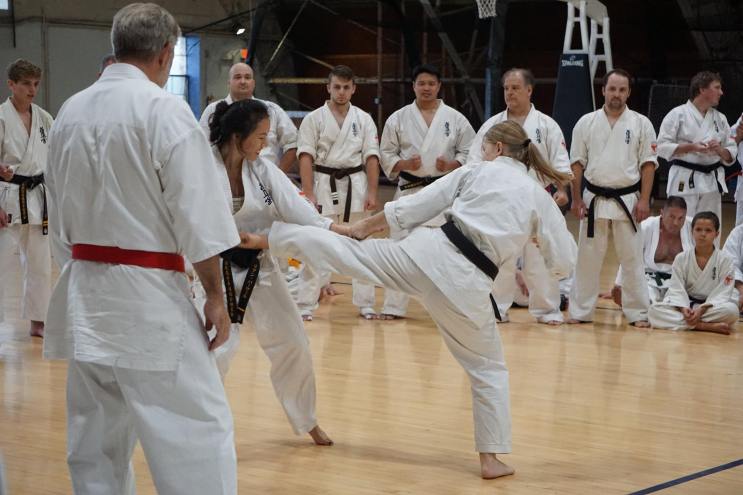GENERAL
BUNKAI: Meaning of the techniques of kata.
CHARACTER: The combination of traits that form the individual nature of a person, including moral quality, integrity, and the development of personal potential. In karate-do, character progresses through the development of the physical, mental, and spiritual.
DOGI: Karate uniform; a uniform of the Way.
DOJO: Place of practice; special place of training.
DOKODO: Way of self-reliance.
EXTREME LIMIT: Pertains to the spirit of technique; the sixth sense.
GIRI: Duty; a lifelong uncompromising obligation.
HANMI: Half forward-facing position, torso at 45-degree angle; the body position for kumite dachi.
HIKITE: Punching chamber.
KANCHO: Head of the house; chairman (in Phoenix Karate, chairman and head instructor).
KARATEKA: A practitioner of karate.
KI: Inner energy.
KIAI: Concentrated shout displaying a joining of inner energy. Usually used in one of the following contexts:
- To show spirit.
- To help take a punch.
- To help give a punch.
- To give an element of surprise.
KIAI IRETE: Kiai with purpose.
KIME: Focus.
KIMEWAZA: Finishing technique.
KOHAI: Students who have not yet attained the rank of shodan. They serve as a foundation of the Phoenix Karate-Do Association and are ultimately the source of future Yudansha.
MAWATE: Turn.
MENTAL: The thought process (thinking, learning, reasoning).
OBI: Belt.
PHOENIX ORDERS: Daily discipline of the Yudansha.
PHYSICAL: Development of endurance and musculature.
REI: Bow.
RYU: School.
SEMPAI: Senior. Sempai are essentially senior Kohai and are usually either shodan or nidan. They have learned and are relatively proficient with many of karate’s physical movements. Having a firm understanding of karate’s underlying philosophies, the title of Sempai signifies ending of preliminary training and the beginning of advanced karate. It necessitates not only a dedication to one’s own development but dedication to that of the junior Kohai.
SENSEI: Instructor. The title indicates “those who have experienced it before.” Sensei are instructors of the art who also live the art. Sensei are usually sandan or above.
SHIHAN: Senior instructor. Shihan have demonstrated lifelong interest in and commitment to the art of karate. Shihan are expected to live the art and be originators and sources of development for karate-do. Godan and above.
SOSAI: President. Title adopted by Mas Oyama in the mid 1980s.
SPIRITUAL: One’s ongoing involvement in seeking meaning and purpose in human existence. It includes a deep appreciation for the depth and expanse of life and the natural forces that exist in the universe.
TAI OTOSHI: Over-the-shoulder throw.
TOBI: Jump.
WAZA: Movements.
YAME: Stop.
YOI: Ready.
YUDANSHA: Black belt.

DIRECTIONS AND TARGETS
AGE: Rising.
AGO: Chin.
CHUSOKU: Ball of the foot.
GAMMEN: Face.
GYAKU: Reverse; rear.
HIDARI: Left.
HIJI: Elbow.
KOMIKAMI: Temple.
MIGI: Right.
MOROTE: Double or in conjunction with oi or gyaku; means reinforced.
OI: Front.
OROSHI: Descending.
SAKOTSU: Collarbone.
SUNE: Shin.
URA: Backwards-turn movement.
USHIRO: Rear; to the back.

BLOCKS
CHUDAN SOTOT UKE: Middle outside-to-in block.
CHUDAN UCHI UKE: Middle inside-to-out block.
GEDAN BARAI: Lower parry.
HAITO UKE: Ridge-hand block.
HIJI UKE: Elbow block.
JUJI UKE: Cross block.
JODAN UKE: Upper block.
KAKE UKE: Hook block.
KAKE MAWASHI UKE: Circular hooking block.
KOKEN HIJO UKE: Wrist block/sliding wrist block.
MAWASHI UKE: Double circular block.
OSAE UKE: Suppressing block or parry (pushing opponent’s hand down or to the side).
SUKUI UKE: Scooping block.
SUNE UKE: Shin block.
TENSHO UKE: Cover.

STRIKES
AWASE TWUKI: U-punch with hands coming from hikite.
HAISHU UCHI: Back-hand strike.
HAITO UCHI: Ridge-hand strike.
HAITO GAMMEN UCHI: Ridge-hand strike to face.
HIJI ATE: Elbow strike.
NUKITE: Spear hand.
SEIKEN AGE TSUKI: Rising thrust.
SEIKEN AGO TSUKI: Fore-fist thrust to chin.
SEIKEN CHUDAN TSUKI: Fore-fist middle thrust.
SEIKEN GEDAN TSUKI: Fore-fist low thrust.
SEIKEN JODAN TSUKI: Fore-fist high thrust.
SEIKEN JUN TSUKI: Punch to the side with body facing forward.
SEIKEN SHITA TSUKI: Inverted short punch.
SEIKEN TATE TSUKI: Vertical-fist thrust.
SHOTEI: Palm-heel strike.
SHUTO GAMMEN UCHI: Knife-hand strike to kidney area.
SHUTO HIZO UCHI: Knife-hand strike to kidney area.
SHUTO SAKOTSU UCHI: Overhead knife-hand strike to collarbone.
SHUTO SAKOTSU UCHIKOMI: Straight knife-hand strike to collarbone.
SHUTO UCHI UCHI: Inner knife-hand strike.
TETTSUI: Hammer fist.
URAKEN GAMMEN UCHI: Back-fist strike to face.
URAKEN HIZO UCHI: Back-fist strike to kidney area.
URAKEN MAWASHI UCHI: Hooking, round-house back-fist strike.
URAKEN SAYU GAMMEN UCHI: Left-right back-fist strike to face.

KICKS
AGE KAKATO USHIRO GERI: Rising rear heel kick.
ASHI BARAI: Sweep.
FUMIKOMI: Stomp.
HIZA GERI: Knee.
KAKE GERI: Hook kick.
KIN GERI: Front snap kick to the groin.
MAE GERI: Front snap kick.
MAE KAEGE: Front straight-leg high kick.
MAWASHI GERI: Roundhouse kick.
SOTO MAWASHI KAEGE: Outside crescent kick.
TOBI MAE NIDAN GERI: Double jumping front kick.
USHIRO GERI: Back straight kick.
USHIRO MAWASHI GERI: Wheel kick.
YOKO GERI: Side kick.
YOKO KAEGE: Side straight high kick.

STANCES
KAKE DACHI: Hooked stance with 80/20 weight distribution.
KIBA DACHI: Straddle stance with 50/50 weight distribution.
KOKUTSU DACHI: Back stance with 70/30 weight distribution.
KUMITE DACHI: Fighting stance with 50/50 weight distribution.
MOROASHI DACHI: One-foot-forward stance (walking stance) with 50/50 weight distribution.
MUSUBI DACHI: Open-toe stance with 50/50 weight distribution.
NEKOASHI DACHI: Cat stance with 80/20 weight distribution.
SANCHIN DACHI: Immovable stance with 50/50 weight distribution.
SOCHIN DACHI: Diagonal straddle stance (often in low, crouched position) with 90/10 weight distribution.
TSURUASHI DACHI: Crane stance with weight 100 percent on back foot.
ZENKUTSU DACHI: Forward stance with 70/30 weight distribution.
YOI DACHI: Ready stance with 50/50 weight distribution.

KATA REQUIREMENTS
YELLOW: 7th KYU
BLUE: 6th KYU
GREEN: 5th KYU
PURPLE: 4th KYU
BROWN: 3rd KYU
BROWN: 2nd KYU
BROWN: 1st KYU
BLACK: SHODAN
- Kata above (15)
- Develop personal kata
BLACK: NIDAN
- Garyu
- Saifa
BLACK: SANDAN
- Seienchin
- Seipai
BLACK: YONDAN
- Sushiho
